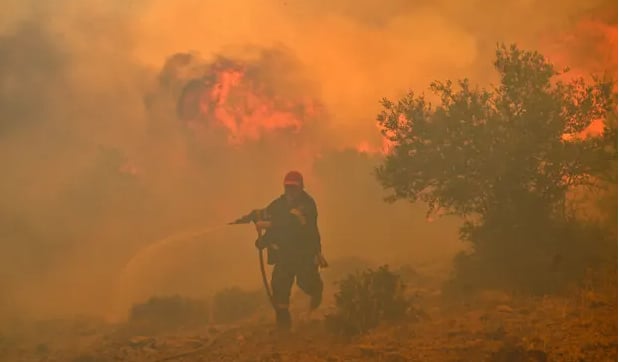November 28, 2025 | 01:03 GMT +7
November 28, 2025 | 01:03 GMT +7
Hotline: 0913.378.918
November 28, 2025 | 01:03 GMT +7
Hotline: 0913.378.918

A firefighter runs as he tries to control a wildfire in New Peramos, Greece, as extreme heat grips much of Europe including Italy and Spain. Photograph: AFP/Getty Images
The climate crisis is moving into uncharted territory as much of the northern hemisphere endures a blistering heatwave, many countries are deluged with rain, sea surface temperatures reach new heights, and Antarctic sea ice new lows. A number of climate records – some unofficial – have tumbled in recent weeks.
Many factors have combined for this to happen, including climate change but also the El Niño weather event, and the northern hemisphere summer.
“The northern hemisphere has a lot more land, it means this time of year just tends to be hotter globally than in southern hemisphere’s summer,” says Dr Kim Reid from Monash University.
“And so this combination of this background warming from global warming, El Niño and the fact that it’s the hottest time of the year for the globe means that we’re just seeing all these records tumbling, all at once.”
While the UN’s World Meteorological Organization and the US National Oceanic and Atmospheric Administration have both declared a Niño is in place, Australia’s Bureau of Meteorology has so far held back from declaring one, saying the atmosphere is not yet giving the typical signals.
The record for global average temperature has been broken a couple of times in the past few weeks, according to a model of average air temperatures at two metres, created by the NOAA. Although, as this data is derived from a model and not direct observation, it is not an “official” climate record.
The model is based on observational data from weather stations, balloons, satellites and other sources and allows climate scientists to get an idea of the temperature over a wider area and create an average for the entire globe.
The chart above shows the global average derived from the model, but maps also show the positive temperature anomalies – the difference between current temperatures and the long-run average – spread across much of the Earth’s surface in June.
Even as the air temperatures have been elevated, the NOAA models show sea surface temperatures are also higher than in recent decades. Monthly data shows that the temperature anomaly has been positive and on an upward trend for decades.
The ocean stores a lot of the excess heat from global heating – up to 90% in recent decades.
“Because we’ve had La Niña the last few years, a lot of the heat has gone into the ocean,” Reid says. “It’s sort of been hidden from us at the surface for a bit. And now as we’ve flipped from La Niña into El Niño, a lot of this ocean heat is now rising up to the surface.”
While the air and sea surface are seeing greater than average heat, new records are being set for sea ice in Antarctica – for how little there is. The lack of sea ice extent is continuing a trend – a new record has been set several times over the past few years.
Satellite data from the National Snow and Ice Data Center shows that not only is 2023 a significant outlier, 2022 ended with some of the lowest sea ice extents on record. But the gap to the long-run average for this time of year appears to be getting larger.
But Reid warns that the Earth – the climate – is a complex system, with many moving parts. What is happening to sea ice in Antarctica, for instance, also has to do with winds, storms and pressure systems.
“We’ve got, of course, the background climate change, we’ve got the seasonality, the fact that it’s summer, the fact that it’s now El Niño, and then there’s also what we call effects from aerosols. So these are tiny particles like sulphur dust, sea salt, that can reflect incoming solar radiation. And [all this] can control the planet’s temperature.”
(The Guardian)

(VAN) A new study reveals how the simultaneous effects of ocean acidification, salinity and loss of oxygen are making the world more fragile.

(VAN) Hopes are growing that the creation of the first 3D turkey gut model could be a turning point in the battle against the virulent blackhead disease.

(VAN) Tyson, America’s biggest meat supplier, plans to shutter one of its largest beef processing plants as the industry continues to struggle with low cattle supplies and political pressure from Washington.

(VAN) New FAO study shows how digital solutions are empowering farmers and fishers to prevent losses and build resilient agrifood systems.

(VAN) Brazil's COP30 presidency pushed through a compromise climate deal on Saturday that would boost finance for poor nations coping with global warming but that omitted any mention of the fossil fuels driving it.

(VAN) Poultry farmers in the UK have been warned that they could face one of the worst winters yet for bird flu.

(VAN) Prices of main-crop paddy have risen sharply, with jasmine rice hitting 16,100 baht per tonne — the highest level in years.